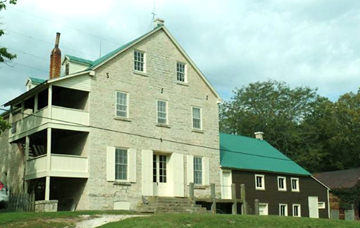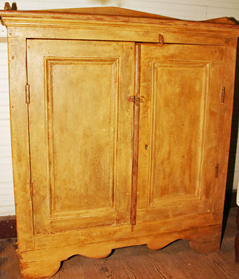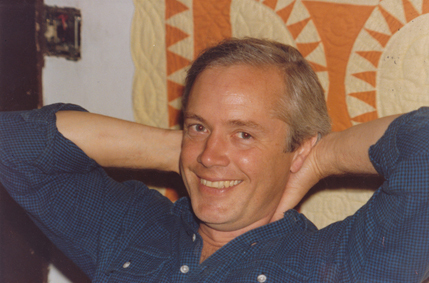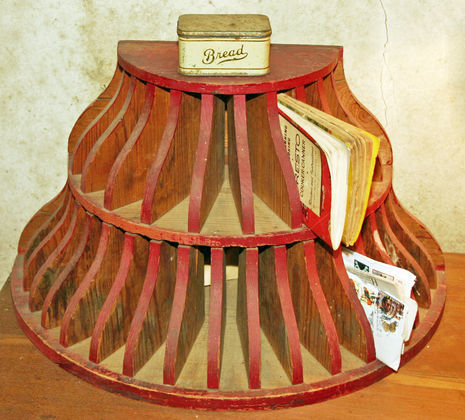It's 8 a.m. on a Saturday morning, and I'm standing under a heavy sky in a muddy yard behind a three-story structure of hand-hewn limestone in the middle of nowhere.
Everything feels wrong.
This place -- buildings, woods, fields, a creek across the road -- had radiated warmth, strength and a sense of gentle peace from the first time I saw it in 1979. But on an October morning 35 years later, it feels cold, fragile and forbidding.
Death can do that.
The great stone building hugs the west side of County Road N about 25 miles southwest of Hermann, Mo. 
In 1979, it was abandoned and in disrepair, but when it was built in 1860, it was alive with commerce and community, a general store serving families scattered across rich Missouri farmlands. A road sign says this is Hope.
Photos courtesy of Cathy Ediger and Schneider Auctioneers
In 1979, Peter Dircks was restless 31-year-old Minnesotan visiting friends in St. Louis when he, too, saw Hope for the first time. Dismissing the disrepair, he knew immediately that this was where he needed to be. He recalled Hope to life, eventually owning the general store and its outbuildings and 25 acres of land. It was the center of his personal and professional existence for three-plus decades.
The feeling in Hope started to shift, inevitably, after Peter's death in 2013 from esophageal cancer. For a couple dozen friends and family members of his close circle, it was profoundly traumatic and disorienting.
Peter Dircks at Hope
Peter and I met in 1965. We were 17-year-old college freshmen living in adjoining shabby rooms on a floor full of misfits in a pit of a dorm three blocks west of the White House on the campus of George Washington University.
We both could be silly and serious, confident and insecure. We both were angry and anxious about the Vietnam War and the draft, both wrapped up in music, and both sorting out who we were and pretending we already knew. For the next nearly half a century, there was no one I trusted more or confided in more completely.
So, no, nothing felt right at Hope at 8 that morning, a year and two days after Peter's passing. In 90 minutes, Schneider Auctioneers LLC -- under the protective direction of Peter's sister, Cathy Ediger, and her husband, Jon Ediger -- would start auctioning off Peter's massive accumulation of professional and personal belongings: furniture, folk art, Missouri antiques, hand and power tools from a fully equipped workshop, home furnishings, vintage artwork, firearms, vehicles, and a mind-boggling array of building parts and construction materials.
The Schneider folks had prepared for a huge turnout. They knew that an auction of Peter Dircks' possessions would be viewed as a once-in-a-lifetime opportunity, literally. Throughout central Missouri and beyond, his artistry and craftsmanship as a hands-on restorer of historic buildings and their contents had been universally admired and in much demand. So had his ability to manage skilled crews he selected to work alongside him on large-scale projects.
Indeed, at the time of his death, Peter was in charge of building restoration and construction for the Hermann Farm and Museum, a multi-million-dollar living-history development of the Dierberg Educational Foundation on 160 acres just east of downtown Hermann.
Sure enough, Hope was overrun with strangers on that dismal Saturday, hundreds of them swarming the grounds trying to inspect pieces they might want to bid on.
Even in the comforting presence of other friends and his devoted family, this felt wrong. Strangers had no business here. They shouldn't have been rooting around in Peter's things. For that matter, wasn't it wrong to sell these things at all, things that were a part of him, things that seemed to embody who Peter was -- our friend, our brother, our uncle, our brother-in-law, our colleague and co-worker, our beloved?
Maybe, but the reality was that everything felt wrong because at the heart of everything was that Peter had died and left us.
The auction proceeded anyway, the hordes traipsing back and forth across the property as bidding shifted from items spread across the backyard, to items laid out on flatbed trucks in a field, to items lined up inside the general store and the workshop, to items stacked in and around the monumental barn.
The hours ticked by, the rhythm of selling settled in and something strange happened: The angst began to ease. As it did, I started to wonder whether auctioning off Peter's things might be, well, if not entirely right then maybe not entirely wrong, either.
 Up for sale went the tables, sofas and iron implements; the brightly enameled wood-burning kitchen stoves, books, chairs of all sorts, ancient wooden trunks, rag rugs and hooked rugs; cupboards, cabinets, and gigantic wardrobes; walnut beams from a room-size weaving loom, piles of quilts, coverlets and loose fabric; and tall stacks of weathered wood siding, windows and paneled doors rescued from abandonment and decay.
Up for sale went the tables, sofas and iron implements; the brightly enameled wood-burning kitchen stoves, books, chairs of all sorts, ancient wooden trunks, rag rugs and hooked rugs; cupboards, cabinets, and gigantic wardrobes; walnut beams from a room-size weaving loom, piles of quilts, coverlets and loose fabric; and tall stacks of weathered wood siding, windows and paneled doors rescued from abandonment and decay.
Some of Peter's relatives and friends, including me, began to participate. We bid, and sometimes we bought. What better custodians of his things, I told myself, than the people who knew and loved him?
Over the course of the long, sad day, a truth emerged from the drizzly mist. It was by no means a revelation, and it would have been clear to us all along, I think, if this hadn't been about Peter and his things and his place at Hope. The obvious truth was that things, no matter how unique and wonderful, don't define the people we know and love and sometimes lose.
You might make a case that Peter's remarkable body of work defined him, at least to a degree: his reclamation of Hope, the meticulous reconstructions at Hermann Farm, the flood-ravaged historic homes he restored, the dilapidated old structures he secured, rebuilt and transformed into beautiful living spaces for private clients.
But the essence of Peter Dircks lies, as it does for us all, in what we keep of him inside us.
These are memories, of course. Memories of poignance and irreverence, of joy and wonder and sorrow, of laughter and crazy dancing, of shared secrets. Memories of unwittingly pitching camp in a town dump, getting a phone call with bad news about John Lennon, overcoming financial crises, hitching a ride with a wild man in Newfoundland, tuning a portable radio to a too-late, late-night political speech, gossiping shamelessly. Memories of marriages and divorces, injuries and illnesses and recoveries. And even memories of a final illness from which recovery was not to be.
(A version of this column originally appeared in the St. Louis Jewish Light.)


